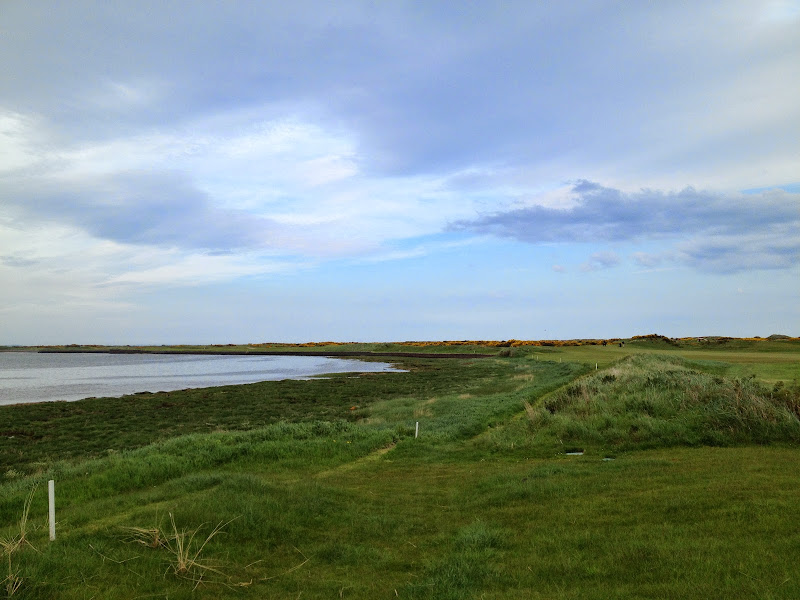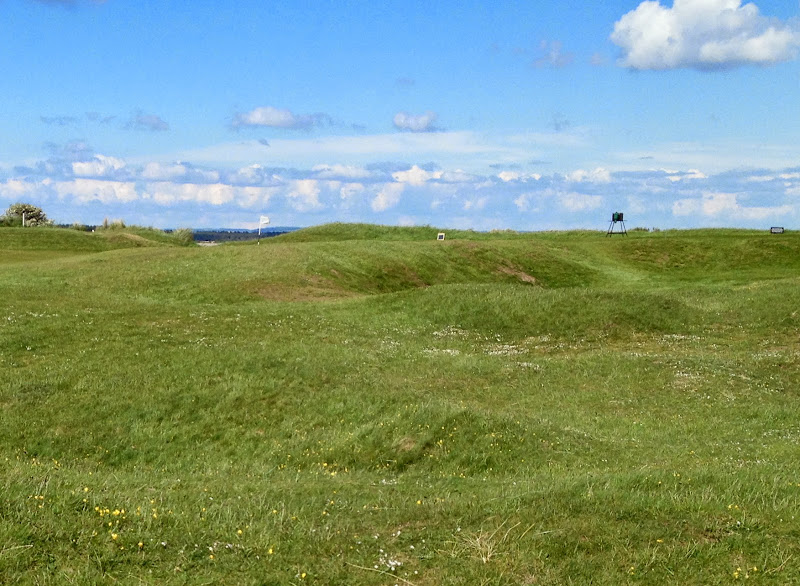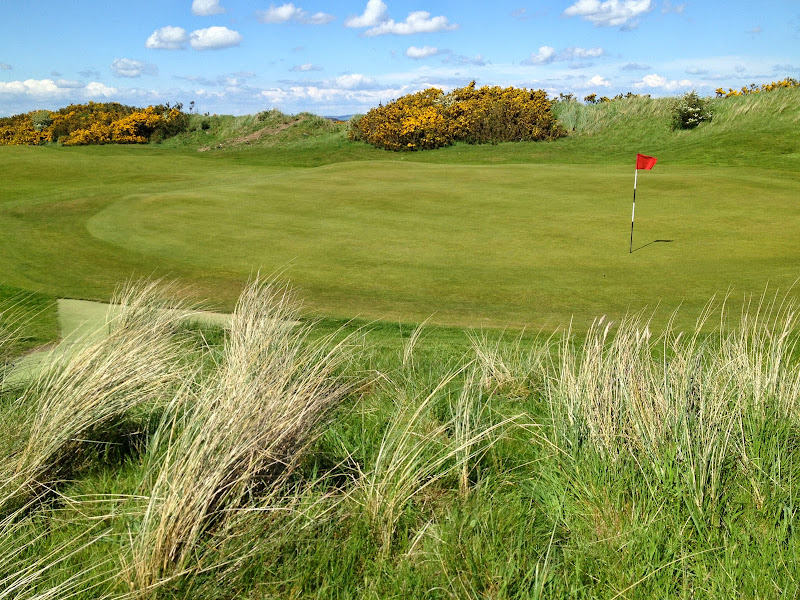St. Andrews is, of course, a popular destination for readers of and contributors to this website, but as I was planning my trip I found it quite difficult to find many detailed descriptions of either the Eden Course or the New Course. Thus, I present a short profile of each course in the same style as my earlier photo/commentary threads, even though I think only the front nine of the Eden really merits serious study. (I know there are many fans of the New Course, but the New didn't have the same draw for me as most of the other courses I played on my trip.)
Other posts on courses from this trip can be found at the following links:
Pasatiempo Golf Club:
http://www.golfclubatlas.com/forum/index.php/topic,58052.msg1379095.html#msg1379095Extremely limited perspective on golf in mainland China:
http://www.golfclubatlas.com/forum/index.php/topic,58052.msg1380004.html#msg1380004Royal Aberdeen Golf Club:
http://www.golfclubatlas.com/forum/index.php/topic,58052.msg1386159.html#msg1386159Balcomie Links, Crail:
www.golfclubatlas.com/forum/index.php/topic,59397.0.html-----
The Eden Course at St. Andrews occupies a triangle to the west of the 15th through 12th fairways of the Old Course and south of the Eden Estuary. It retains 11 or 12 holes from the original 1914 Harry Colt design, and the greens (in particular) from the original holes are well worth a look for any visitor to St. Andrews. I played the Eden my first day in town, walking up and teeing off as a twoball with my father about 25 minutes later. For me, the firm and broken ground in and around the fairways also served as a welcome introduction to links golf.
The first eight holes feature a remarkable set of greens that brought smiles to my face, even if I didn't score particularly well on them. They played firmly enough that a well-hit wedge could bounce and roll some 60 to 80 feet from the rough, but that day were frustratingly slow--certainly the slowest I played all week aside from the Himalayas. The real meat of the course lies in the land closest to the Estuary that is left over from the original Colt course: holes 3-5, 7, and 8 of today's routing, plus the 11th green. It's too bad that when the Links Trust decided to eliminate 4 holes and reroute others, Donald Steel did not try to emulate the original Colt greens for the new holes; the new greens mostly lack interest, and otherwise don't feel the same--don't seem to have the same random, natural contours that emerged from the land 100 years ago. I won't say another word about the weaknesses of the course, except to advise any of you not to expect that holes 13-16 are really worth playing for the sake of studying good architecture.
I hope that by examining the photos that follow, any readers who haven't yet played the Eden will get a sense of the course's beauty, its openness and playability, and the severity of penalties that will be faced for mishit shots, determined almost entirely by the contouring of the greens and surrounds rather than by bunkers or thick rough.
Originally a 200-yard par 3, the green of the first hole, with its unusual and severe spine, (326/270 from back/front tees) immediately awakens the modern golfer and gives a great preview of what is to come on the front 9 of the Eden. It appears that the original tee box, behind the gorse right of the fairway, is still available for anyone who wants to experience the Colt hole.
Two views of the first green:


The third (417/402) doglegs right at 200 yards from the tee, and begins a very neat stretch of holes. With the precision required on the approach, hitting driver and erring for the left rough is a good idea; this will allow an approach playing away from the Estuary.
Again, two views of the third green, falling off sharply at short left:


The fourth (273/240) is a very driveable par 4, almost the mirror image of the 9th at the New Course but with a raised, flattish green (relative to other greens on the course) presenting difficulty for pitches after drives missed either left or right of the green. The margin for error on either side of the green is relatively generous, as long as the tee shot is not severely blocked.
The bailout left of the fourth fairway:

... and the view from behind the green, showing the dry land to the right:

I realize that not all of these photographs are well composed, but I really do think they have something to offer for students of architecture.
The fifth (144/119) and eighth (178/139) holes share a tee box and cross over each other as the 7th and 11th on the Old Course do. Both play over a bumpy fairway to smallish greens with significant false fronts. (There is probably some room for a pin on the front of each, but not much.) Both holes, too, offer severe penalties for missing the green, with the huge dune between them in play for three of our four tee shots on the two holes.
The view from the shared tee:

The fifth green:

From behind the fifth green:

A pulled shot at the eighth would leave one with a steep pitch to the white flag [the red one at left is the 11th]:

The seventh (346/291) doglegs left around the Estuary in Cape-like fashion, and offers an opportunity for gamblers to clear a ridge (250 from the tee) and hope for a favorable kick on the firm but unpredictable ground the rest of the way to the green. Otherwise, a safe layup well away from the water is advised. If the hole is cut on the back portion of the green, a shot played at the left edge of the green will roll down near the hole for a nice birdie putt, as my father discovered.

The 11th (375/327) is the last of Colt's really interesting green complexes. Be sure to take a look at it as you walk from the 9th tee, and when you leave your approach shot short right, as we did, be especially sure to hit your putt hard enough to get up the ridge and stay on the green.

There's a tremendous amount of room between the front bunkers and the front edge on 11:

Although the 17th is Colt's, the design is pretty puzzling to me: doglegging right along the arc of the Old Railway Line (OB), it incorporates renditions of both the Principal's Nose and the 17th green at the Old Course (at least, as I see it). One compelling reason to play the back 9 of the Eden may be to attempt a shot to the left of the Principal's Nose. All in all, it feels odd to see these features incorporated into a course so close to the original, even though I know they were not recently added to appease golfers who didn't get a chance to play the Old.
-------------
The New Course at St. Andrews was designed in 1895 and is credited to Old Tom Morris, but the Crabtree and Malcolm biography of OTM disputes that accreditation. The first five holes lie immediately east of holes 2 through 6 at the Old Course, and like the Old Course, the New follows a mostly out-and-back routing, with the 9th hole played parallel to the Eden Estuary and the last few holes offering terrific views of the town and cliffs beyond.
The holes follow the movement of the land with no pushed up greens or obvious artificial contouring. Rather than employing several dozen penal bunkers, devilish greens contouring, or the sea as primary hazards, the New Course's main defense seems to be that several of the tee shots lack visual definition, even if they are not blind per se. I do not mean to suggest that architects and superintendents should ensure that players can tell exactly where fairways end and rough begins while standing on the tee, by employing tree lines or bunkers built above grade. Instead, I use this point to highlight one of the strengths of the Old Course: while not all hazards are visible from the tee or approach shot, they are clearly defined from the air and a first-time player can use the features that are visually apparent and the Links Trust's excellent yardage book to work out the locations of all the blind hazards.
Though the New Course's hazards are not always visually apparent--and I may be overblowing this shortcoming of the course--the course's setting amongst the gorse and dunes is without a doubt stunning. It's no wonder that the Links Trust gives the New second billing among the courses in town, given that the Eden is no longer the masterpiece it must have once been. However, I certainly wouldn't give up an opportunity to play the Old Course to give myself another chance to figure out how to play the New better.
The fourth hole (369/351), a dogleg left, turns and descends 127 yards from the front edge of the green, and the next several dozen yards of fairway, blind from the tee, are full of bumps and hollows. So the first strategic decision on the hole is whether to play a shorter tee ball into the visible section of fairway short of the bend, or to take on the moguls and uncertain target line, risking running through the fairway. The green is deceptively deep, so be sure to check the pin position and your playing angle on the approach.
The fifth (180/158) has one of the more interesting greens on the course, with a design feature I can't recall seeing anywhere: a V-shaped hollow located about 1/3 of the way from the right side and occupying roughly half of the green depth. Don't miss it on the wrong side of the hollow, seen behind the pin in the photo below:

The eighth is a short par 5 (504/464) with a green nestled between and behind two rather large dunes. Cross bunkers may deter long players from hitting driver off the tee, but the real defining feature of this hole is the pair of dunes as you'd definitely rather play a pitch from the fairway short of the green than risk losing a ball in the gorse or long rough on those dunes. The eighth green as viewed from the ninth tee:

The ninth (225/204) is one of the most beautiful yet brutish par 3s anywhere. The Eden Estuary to the left is marked as OB, and the fairway contour follows the Estuary arcing gently to the right. As seen from behind the green:

Dunes all the way along the right side provide a severe penalty for any players who choose a safer miss:

My father thought the 10th (464/427) was the toughest hole we played all week. A blind shot over a dune is followed by an approach over and through smaller dunes to a green that, once reached, does little to defend itself.
10th tee shot over the aiming pole:

10th green amongst the dunes:

The 11th through 13th holes occupy similar hillocky and hollowy terrain before returning to a milder landscape for the finish. Here's the view of the 13th (157/133) from its tee:

Although it does play over milder ground at the end, from the 15th green through the end of the round, terrific views of the town and cliffs are offered. In the below photo of the 17th hole (229/192) (the green is between the Old Course Hotel and Hamilton, and the second fairway of the New is on the right side of the photo), note that the bunker in the foreground is a full 30 yards short of the front of the green:

------------
It's clear that the Eden course was once a masterpiece, but I have a tougher time assessing how the New stands in the world. In America, the firm and fast and broken ground would stand out and make it a destination for that reason alone, especially on the holes in the middle of the round from 4 to 13. But the holes themselves didn't feel that special to me, and when I imagine them laid out in a parkland setting, I wouldn't think much of them. Given that you have the luxury to spend several days or months in Fife, the New is not a bad choice, and the Eden is a great choice for 9 or 14 holes at the end of a day. But I wouldn't make either of them the focus of a return trip to the area.
------------
I did make the Himalayas a priority, and while it was fun and interesting--certainly the most undulating and the largest putting green I've ever been on--the green was so slow that it was terrible as a place to warm up. I wonder if it's always (i.e., since the 19th century) been maintained at a slower speed than the greens on the other courses on the property. At any rate, it's a great community resource and a nice place to spend 45 minutes. Here are a few of my photos from it:


